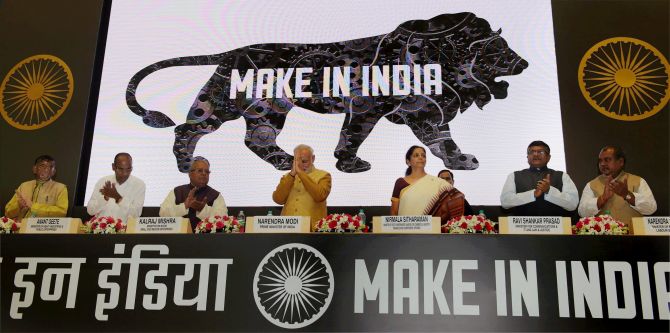Make in India, an initiative to enthuse the domestic manufacturing sector and invite foreign players to “make in India” was launched by the Government of India on 25 September 2014. 4 Years after its launch how does this project affect the life of a common Indian and more importantly, what is its contribution towards strengthening the Indian economy. Well! here’s the first big result.
The growth of the manufacturing sector increased by 9.1 percent in the last quarter of the fiscal year 2017-2018 while the growth in the construction sector increased with a rate of 11.5 percent. The data released by Central Statistics Organization (CSO) on 31st May on GDP clearly suggested that Indian economy is on the right track. The sectors related to manufacturing like mining, construction etc were the largest contributors to the growth of the economy. In the last quarter, GDP growth was at a whopping 7.7 percent while the overall annual growth was at 6.7 percent.

The healthy growth in manufacturing suggests that Make in India coupled with GST had a positive effect on the sector. The manufacturing sector employs large-scale semi-skilled and unskilled labor, therefore, growth in this sector will also solve the under-employment problem that India is facing over the past few dacades.
The substantial growth in manufacturing was praised by economists and industry leaders. Axis Bank chief economist Saugata Bhattacharya said, “The growth acceleration of over FY18 quarters led by construction and manufacturing, and consequently by investment, is quite striking, even adjusting for base effects.”
Manufacturing is one of the sectors on which the Modi government was focused on since coming to power. To give a boost to manufacturing, government launched the Make in India program on 25th September 2014, just 4 months after coming to power. Under the Make in India program, FDI policy was liberalized with 100% Foreign Direct Investment (FDI) being permitted in all 25 sectors, except for space (74%), defense (49%) and news media (26%). As a result, India emerged as the top destination globally in 2015 for foreign direct investment (FDI), surpassing USA and China, with $60.1 billion FDI. The greater inflow of investment is helping India to make a strong manufacturing base which is necessary for a country with a large population. China, the closest to having a massive population like India’s, depends on the economy to employ its vast majority of people because jobs in the service sector are limited, which employ only highly skilled labor. India is growing into a big manufacturing hub of mobile phones since the Modi government came to power. There were only 2 mobile phone manufacturing factories in India, while today there are 120 factories.
The GST also gave a boost to manufacturing as it made it easier to do business across the country for smaller manufacturing units based in any city or state. The uniform tax regime introduced by GST also helped in bringing many informal business into the formal economy. Under the new tax laws, manufacturers can claim input tax credit on input goods, which seems to be a positive sign for cash flow. State-border check posts, established to scrutinize documents and location-based compliance, adversely impacted the overall production and logistics time, which reduced the efficiency of Indian manufacturers. Now that there are no such check posts, time to reach the end consumer is effectively reduced. Finance Secretary Hasmukh Adhia suggested that GST is largely responsible for manufacturing growth.
2/2What is most noticeable is the increase in the Growth Rate of GVA of Manufacturing Sector in the last two Quarters of 2017-18 at 8.5% and 9.1% at constant price. We would like to believe that GST has given a big boost to the Industrial Sector.
— Dr Hasmukh Adhia (@adhia03) May 31, 2018
So the efforts by the Modi government to boost manufacturing are now reaping benefits for the Indian economy. The manufacturing sector is important because it gives jobs to a lot of semi-skilled and unskilled people who constitute a majority of the Indian population. The positive notes in the sector suggest that India is establishing itself as a manufacturing hub. This will help India to attain double digit economic growth and generate large scale employment.































